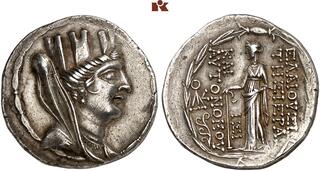| Fritz Rudolf Künker GmbH & Co. KG > Auction 402 | Auction date: 14 March 2024 |
| Lot number: 413 Price realized: 3,400 EUR (Approx. 3,702 USD) Note: Prices do not include buyer's fees. | Show similar lots on CoinArchives Find similar lots in upcoming auctions on |
| Lot description: CILICIA. ELAIUSSA-SEBASTE. AR-Tetradrachme, 95/83 v. Chr.; 16,45 g. Tychekopf r. mit Schleier und Mauerkrone//Aphrodite (?) steht l. mit nicht eindeutig bestimmbarem Gegenstand, l. Aphlaston. de Callatay, S. 72; Houghton/Bendall in ANSMN 33 (1988) -; SNG France 2, vergl. 1152; SNG Levante Suppl. 221. Feine Tönung, kl. Kratzer, gutes sehr schön Exemplar der Auktion Giessener Münzhandlung 102, München 2000, Nr. 298. Die Tetradrachme von Elaiousa – eine der am besten erhaltenen Münzen dieses Typus – zeigt auf der Vorderseite die Büste der Stadtgöttin. Sie trägt eine Mauerkrone, an der ein Kopfschleier befestigt ist, ferner Ohrringe und ein Halsband. Der Stolz auf die eigene Stadt wird klar, wenn man auf der Rückseite AVTONOMOV als Teil des Stadttitels liest. Er hilft auch bei der Datierung. Die Münze dürfte nach dem Tod des Seleukidenherrschers Seleukos VI. (94 v. Chr.) und vor der Einbeziehung der Stadt in das Reich des armenischen Königs Tigranes (83 v. Chr.) geprägt worden sein (vgl. Houghton – Moore 1988, 67-69; Rigsby 1996, 464 f.). Nur in diesen zehn Jahre war die Stadt frei. Auf der Rückseite ist in einem Kranz das Bild einer Gottheit wiedergegeben, die versuchsweise mit Aphrodite identifiziert wurde. Allerdings stützt kein aphroditespezifisches Attribut diese Deutung und wir wissen auch aus anderen Zeugnissen nichts davon, dass der Aphroditekult eine besondere Bedeutung für Elaiousa gehabt haben soll. Der Kranz, der die Gottheit umgibt, macht die Münze zu einer Art Stephanophore, auf der eine führende Schutzgottheit von Elaiousa evoziert wird. Der Titel einer 'heiligen Stadt' weist darauf hin, dass die Ursprünge der Stadt, die einstmals vielleicht zum Stadtgebiet von Korykos gehörte, ein bedeutendes Heiligtum war (Hellenkemper – Hild 1990, 400 f.). Möglicherweise war dieses Heiligtum das der Selene. Nicht ohne Grund sind auf kaiserzeitlichen Münzen von Elaiousa Halbmond und Stern ein Motiv; ein Heiligtum mit einer Gottheit auf einer Kugel oder Scheibe könnte in die gleiche Richtung weisen. In einer Grabinschrift aus der Nekropole von Elaiousa ist die bei Grabräuberei zu bezahlende Strafe an die Mondgöttin Selene zu zahlen. Den Schutz der Gräber vertraute man häufig Gottheiten an, deren Heiligtümer in einer Stadt wichtig und mächtig genug waren, um als Ordnungs- und Strafmacht zu fungieren. Vielleicht weist das Diadem auf die Mondsichel der Selene hin. Wenn sie eine führende Stadtschützerin von Elaiousa war, könnte sie auch als Patronin der für die Inselstadt so wichtigen Schifffahrt fungiert haben und deshalb ein Steuerruder in der Hand halten. [JN] This tetradrachm of Elaiousa – one of the best-preserved specimens of this coin type – shows the bust of the city goddess on the obverse. She wears a mural crown with an attached head veil, as well as earrings and a necklace. The fact that AVTONOMOV/autonomous is part of the city title clearly shows how proud the city was of its status. This observation makes it possible to precisely date this coin. It was minted after the death of the Seleucid ruler Seleucus VI (94 BC), to whose dominion the city belonged, and prior to the incorporation of the city into the empire of the Armenian king Tigranes (83 BC) (cf. Houghton – Moore 1988, 67-69; Rigsby 1996, 464 f.). This period of ten years was the only time during which the city was free. Tentative suggestions have been put forward, trying to identify the deity depicted in a wreath as Aphrodite. However, no Aphrodite-specific attribute supports this interpretation and we know of no other evidence that would support that the cult of Aphrodite was of special significance for Elaiousa. The wreath surrounding the deity turns the coin into a kind of stephanophoric tetradrachm – a coin type that evokes a city's leading patron deity. The title of a 'holy city' indicates that the origins of the city, which may once have been part of the urban area of Korykos, were an important sanctuary (Hellenkemper – Hild 1990, 400 f.). It is possible that this sanctuary was that of Selene. It is not without reason that a crescent-and-star motif was used on imperial coins from Elaiousa; a sanctuary with a deity on a sphere or disc could point in the same direction. A funerary inscription from the necropolis of Elaiousa reads that the penalty for grave robbery is to be paid to the moon goddess Selene. Deities with important sanctuaries in a city and sufficient power to act as a force of order and punishment were often entrusted with the protection of graves. The diadem might refer to the crescent moon of Selene. If she was a leading city protector of Elaiousa, she could also have been the patron saint of shipping, which was highly important for the island city, and therefore hold a rudder in her hand. [JN] Estimate: 1000 EUR |  |



